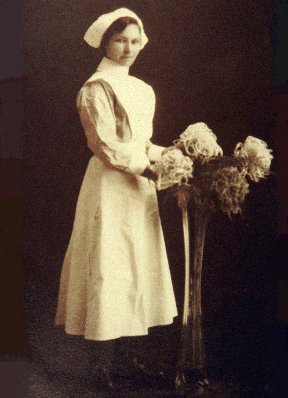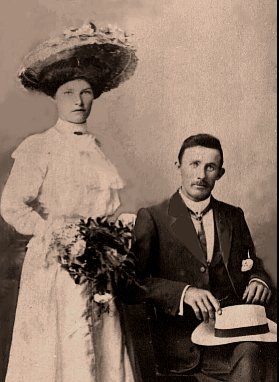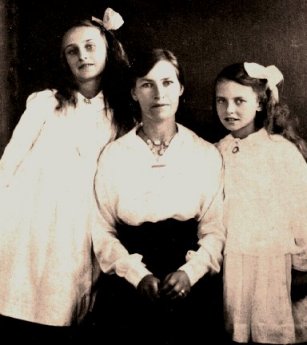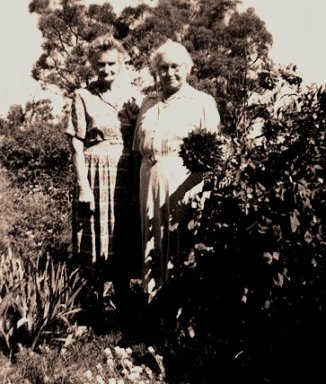 |
||||
(This resumé of Esther Sneddon was written by her daughter, Huldah, and edited by her grandson, Stuart Oliver in 1996.)
Esther Charlotte Warner was born at Moore Creek, New South Wales, on 23 Sep 1888, the first born of three children, to William Edward and Hannah Huldah Warner (nee Hewett). She died in Newcastle, NSW, 1 February, 1968. She had a brother, Herbert Warner, and a sister, Evalyn Warner. Her father was presumed dead when he failed to return from a visit to a brother. It is believed he died of exposure in the bush. It is hard for us today to visualise the arduous conditions that existed in getting from one locality to another, only a short distance away by today’s standards. This occurred when Esther was a child of eight years. Three months later her mother, Hannah Huldah, died. Her uncle, Jessie Warner, carried on the vineyard at Moore Creek, and Esther went to the local school where she was apparently a bright scholar. At the age of 12, she was taken from school and, if reports can be believed, was sent to any of the family members who needed help...sickness, home-help, babies, etc. Perhaps this was the grounding for her future career in nursing. At 17 she married Alfred Sneddon of "Burnhead" Farm near Tamworth, New South Wales, and they lived in a cottage on that property, which belonged to Alfred’s father, James Sneddon. There she had her two children, Huldah Mary (born on her 18th birthday, 23 Sep 1906), and Dorothy Irene (born 15 Mar 1911).
I dimly remember some childhood experiences at "Burnhead"...the horse bolting when I hit it with a quince stick; feeding a little bird that came to us after we rescued it from a bowl of cream; my mother shooting a snake in a piled up timber heap while I held Dorrie (sister Dorothy); Grandfather rocking in his chair and talking to me; quarrels between two bachelor Sneddon brothers. In this Sneddon family my mother was either liked or disliked, and when Grandfather died my father was dispossessed. He had no share in the will, and we had to leave and go elsewhere. The years that followed are shadowy ones . . . . Boggabri, Hallsville (where I went to school for the first time). Father was working away from home (roads, farms, etc.) and was only home at intervals. Then began a share-farming stage. Upper Dungowan and Lower Dungowan (near Tamworth). I remember my mother baking bread, making jam and keeping body and soul together. There was very little money, and the Christmas after I was eleven, she explained Santa Claus to me, asking me not to tell Dorrie. She told me they could not afford presents, and I helped her roll a tiny tin man into a great ball of paper. The fun was in the unwrapping. Then we moved to town (Tamworth) because I had to go to high school. Father’s health was very bad (they never could get to the bottom of it). Mother took in washing and ironing, and only Father had butter on his bread, or mead; we learned the joys of bread and dripping.
As Father’s health deteriorated, Mother knew she had to be the bread-winner. She put away some of her hard-earned money and the year I did my Leaving Certificate, 1922, after sitting for, and passing, a Nurses’ Entrance Exam, she paid for a year’s training at The Royal Hospital for Women (Paddington, Sydney) in Midwifery. She had packed us kids into a boarding school (Dominican Convent, Tamworth) and left Father to be looked after by a family of friends. Mother and I passed our exams together. I went on to University, and she became Nurse in Residence for a Mrs Weaver, who provided maternity care. In 1924 she bought a deceased estate property (in West Tamworth) which had been a Maternity Home. In the same year my Father had the first of many bouts in hospital -- surgery and so on. It was found he had Hydatids in the liver for all those years. Mother established her hospital and was responsible for delivering over 2000 babies. Her original journal of birth records is presently held in Wagga Wagga by the family of her late grandson, Harvey Oliver. She became established and respected, and known for her humanity. She closed her hospital (for her health reasons) in 1939 and moved to Sydney
In 1947 they again moved to Sydney, and we three lived together till I went to the country teaching. They lived on there, where Father died in 1961. Mother continued to live there until she had a heart attack (about 1965, I think). She then moved into a house near my sister at East Hills, but the doctor said she must not live alone. She came to stay with me while we were making arrangements for her, and had a stroke in October, 1967. After many weeks in Royal Newcastle Hospital, she died on 1 February, 1968. A funeral service was held in Newcastle Presbyterian Church on 2 Feb 1968, and I later scattered her ashes from the northern side of Mt Sugarloaf...facing north to Tamworth. I had earlier scattered Father’s ashes from the same spot. That is the story as far as I know it. She was a woman of tremendous moral strength and great courage. She was compassionate and kind, and never ever got over the wonder of the miracle of birth. |
||||
|
||||
| Following is an extract from the Northern Daily Leader dated 17 Nov, 1934: TO THE EDITOR PRAISE FOR AMBULANCE Mr. E. L. Manuel, "Eagle Grange", Niangala, writes: I would like to offer, through the columns of your widely read paper, a word of congratulation to the Superintendent in charge of the Tamworth Ambulance Station, to Driver Burton, and to the service in general. Recently I witnessed an urgent and most distressing call to a remote locality, namely, "Cowsby", in the Niangala district, approximately 60 miles from Tamworth. When the message was delivered, the Superintendent was asked to "step on it", and the reply was, "leave it to us". Only those who have actually travelled on this road in wet weather can form any idea of what it is really like. The last four miles were absolutely impassable, so the road through "Eagle Grange", the adjoining property, was taken. Driver Burton, accompanied by Nurse Sneddon, of "Stirling" Private Hospital, West Tamworth, safely piloted the Ambulance, equipped with chains, to within a mile of where the patient was lying, and from here they took the stretcher and walked the rest of the way. After receiving all aid possible, the patient was carried to the car, and the journey to Tamworth commenced. All who witnessed this wonderful effort admired the pluck of Nurse Sneddon, and the driving ability, together with the courteous manner of Driver Burton. Indeed, every resident of Tamworth and district should be proud of this wonderful service and get behind it with their whole-hearted support. |
||||
|
||||
| Another extract from the Northern Daily Leader -- date probably 1939. VALEDICTORY Mr. and Mrs. A. Sneddon TAMWORTH FAREWELL A farewell and presentation were tendered Nurse E.C.Sneddon and her husband, Mr. Alfred Sneddon, at the Tamworth C.W.A. rest room prior to their departure from Tamworth to take up residence in Sydney. Until recently Nurse Sneddon conducted Stirling Private Hospital at West Tamworth. On her arrival Nurse Sneddon was presented with a bouquet by Molly Greentree. The streamers of the bouquet had been suitably inscribed in gold by Miss L. Wise. In presenting to Nurse Sneddon a chromium toilet set and a cut glass tray, and to Mr. Sneddon a gold tie pin, Dr. T. S. Douglas said that he and Nurse Sneddon had worked together for 15 years in the medical profession. He could not speak to highly of her ability as a nurse. She had a remarkable record and no power on earth could have saved the only patient who had died. Many persons who had been dangerously ill had been restored to health under her care. He wished her happiness and success in Sydney. Dr. Douglas was supported by Mr. Holmes and Mrs. Campbell. In reply, Mr. Sneddon said they would always value the friendships they had made in Tamworth. It was only their duty to do what they could to help everyone in need. At the conclusion of the speeches the gathering sang For They Are Jolly Good Fellows. Supper was then served, after which Mr. L. Sneddon thanked the organisers, Miss Q. Wilson and Mrs. A. Fisher, and others who had assisted to make the evening a success. The entertainment consisted of competitions, games and dancing, arranged by Mr. and Mrs. J. Searle and Mr. and Mrs. Witham. Mr. Searle was M.C. Between the dances songs were sung by Mr. Witham and his son, Allan, the latter also playing the steel guitar. Miss M. Greentree danced the highland fling and Mrs. G. Meincke played for the dancing. The accompanists were Mrs. Witham and Mrs. M. Jones. |
||||
|
||||
An extract from "Weekend Magazine" -- probably from The Northern Daily Leader TIMES HAVE CHANGED SINCE SISTER SNEDDON’S DAYS When MONNIE McKINNON had her fourth child, Margaret, in 1935, it was at Sister Sneddon’s establishment, a private hospital in Bridge St, West Tamworth, that the baby came into the world. In those days the base hospital did not cater for babies or births. The hospital was a two-storey building, near the corner of Denison and Belmore streets, with about three rooms. Monnie remembers today that it cost eight pounds to have her child. Labor, and the first days of motherhood, were a lot different then. "You went to bed for 10 days," says Monnie.
"You got up on the 10th day. But when Margaret was born, old Dr Fitzpatrick had been to Sydney and he came back with new ideas. "He told the nurse to let me up on the ninth day. The nurse didn’t approve, and she told him so, but I got up. "In the labor ward things were different too, although any mum will tell you the pain is still the same, only the ways to handle it are sometimes radically different." For Monnie, and women like her, it was a matter of a whiff of chloroform, which she was given with Margaret. Monnie didn’t see her baby girl then until the next day. At Sister Sneddon’s it wasn’t uncommon to be thrown a handful of safety pins, and told to undo them. It was supposed to take your mind off what was going on below. "You walked about all the time, too," says Monnie. Those were the days too, when they let women stay in labor for days. When you went to hospital you took everything. And as much old linen as you could, because they had no pads, either. You also took a binder. To put around your waist and hold you together. It was supposed to make you feel strong. The baby had a binder, too. In the ‘30s, too, it was a time when swaddling clothes were still in use. Babies were often wrapped tightly. At Sister Sneddon’s there were no basinets for baby to sleep in. He slept in bed with you. You fed your baby, but they did everything else for you. In the labor ward, it was almost a strictly female affair, except for the doctor. It was never, ever, contemplated that fathers be there for the birth. "Good grief, no," says Monnie. No one else was allowed in. |
||||
|
||||
|




